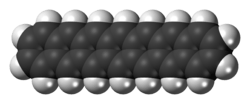Heptacene
 | |
| Names | |
|---|---|
| IUPAC name
heptacene | |
| Identifiers | |
3D model (JSmol) |
|
| ChemSpider | |
PubChem CID |
|
| |
| |
| Properties | |
| C30H18 | |
| Molar mass | 378.47 g·mol−1 |
Except where otherwise noted, data are given for materials in their standard state (at 25 °C [77 °F], 100 kPa). | |
| Infobox references | |
Heptacene is an organic compound and a polycyclic aromatic hydrocarbon and the seventh member of the acene or polyacene family of linear fused benzene rings.[1] This compound has long been pursued by chemists [2][3][4] [5]because of its potential interest in electronic applications and was first synthesized but not cleanly isolated until 2006.[6][7] Heptacene was finally fully characterized in bulk by researchers in Germany and the United States in 2017.[8]
The final step is a photochemical decarbonylization with a 1,2-dione bridge extruded as carbon monoxide. In solution heptacene is not formed because it is very unstable being a reactive DA diene and quickly reacts with oxygen or forms dimers. When on the other hand the dione precursor is dissolved in a PMMA matrix first, heptacene can be studied by spectroscopy. Heptacene has been studied spectroscopically at cryogenic temperatures in a matrix.[9] When dissolved in sulfuric acid the heptacene dication is reported to be stable at room-temperature for more than a year in absence of oxygen.[10] "[Isolated] solid heptacene has a half-life time of several weeks at room temperature."[11]
Derivatives
7,16-Bis(tris(trimethylsilyl)silylethynyl)heptacene was synthesised in 2005.[12] This compound is stable in the solid state for a week but decomposes in contact with air. Its synthesis started from anthraquinone and naphthalene-2,3-dicarboxaldehyde. More stable substituted heptacenes have been reported: with stabilizing p-(t-butyl)thiophenyl substituents[13] and with phenyl and triisopropylsilylethynyl groups.[14]
References
- ↑ Zade, Sanjio S.; Bendikov, Michael (2010). "Heptacene and Beyond: the Longest Characterized Acenes". Angewandte Chemie International Edition. 49 (24): 4012–5. doi:10.1002/anie.200906002. PMID 20468014.
- ↑ Clar, E. (1942), Heptacen ein einfacher, „ultragrüner” Kohlenwasserstoff (Aromatische Kohlenwasserstoffe, XXXV. Mitteil.). Ber. dtsch. Chem. Ges. A/B, 75: 1330–1338. doi:10.1002/cber.19420751114
- ↑ Cyclic Dienes. XI. New Syntheses of Hexacene and Heptacene William J. Bailey and Chien-Wei Liao Journal of the American Chemical Society 1955 77 (4), 992-993 doi:10.1021/ja01609a055
- ↑ 519. Four higher annellated pyrenes with acene character B. Boggiano and E. Clar J. Chem. Soc., 1957, 2681-2689 doi:10.1039/JR9570002681
- ↑ Fang, T. Ph.D. Thesis, UCLA (1986), "Heptacene, Octacene, Nonacene, Supercene and Related Polymers"
- ↑ Photogeneration of Heptacene in a Polymer Matrix Rajib Mondal, Bipin K. Shah, and Douglas C. Neckers J. Am. Chem. Soc.; 2006; 128(30) pp 9612 - 9613; (Communication) doi:10.1021/ja063823i
- ↑ a| Diels-Alder reaction of dibromonaphthalene forming a naphthyne and bicyclo[2,2,2]oct-2,3,5,6,7-pentaene with n-butyllithium in toluene 3 hours at -50 to -60°C 53% chemical yield b| organic oxidation with P-chloranil in toluene 2 hours reflux and 81% yield c] Bishydroxylation with N-Methylmorpholine N-oxide and osmium tetroxide in acetone and t-butanol at room temperature for 48 hours, 83% yield d] Swern oxidation with trifluoroacetic acid in dimethyl sulfoxide and dichloromethane at -78°C, 51% yield e] photochemical decarbonylization in a PMMA matrix at 395 nm
- ↑ Heptacene: Characterization in Solution, in the Solid State, and in Films Ralf Einholz, Treliant Fang, Robert Berger, Peter Grüninger, Andreas Früh, Thomas Chassé, Reinhold F. Fink, and Holger F. Bettinger J. Am. Chem. Soc.; 2017; 139 (12), pp 4435–4442; doi:10.1021/jacs.6b13212
- ↑ Synthesis, Stability, and Photochemistry of Pentacene, Hexacene, and Heptacene: A Matrix Isolation Study Rajib Mondal, Christina Tönshoff, Dmitriy Khon, Douglas C. Neckers, and Holger F. Bettinger Journal of the American Chemical Society 2009 131 (40), 14281-14289 doi:10.1021/ja901841c
- ↑ Einholz, R.; Bettinger, H. F. (2013). "Heptacene: Increased Persistence of a 4n+2 π-Electron Polycyclic Aromatic Hydrocarbon by Oxidation to the 4n π-Electron Dication". Angew. Chem. Int. Ed. 52: 9818–9820. doi:10.1002/anie.201209722.
- ↑ Heptacene: Characterization in Solution, in the Solid State, and in Films Ralf Einholz, Treliant Fang, Robert Berger, Peter Grüninger, Andreas Früh, Thomas Chassé, Reinhold F. Fink, and Holger F. Bettinger J. Am. Chem. Soc.; 2017; 139 (12), pp 4435–4442; doi:10.1021/jacs.6b13212
- ↑ Payne, Marcia M.; Parkin, Sean R.; Anthony, John E. (2005). "Functionalized Higher Acenes: Hexacene and Heptacene". Journal of the American Chemical Society. 127 (22): 8028–9. doi:10.1021/ja051798v. PMID 15926823.
- ↑ Kaur, Irvinder; Stein, Nathan N.; Kopreski, Ryan P.; Miller, Glen P. (2009). "Exploiting Substituent Effects for the Synthesis of a Photooxidatively Resistant Heptacene Derivative". Journal of the American Chemical Society. 131 (10): 3424–5. doi:10.1021/ja808881x. PMID 19243093.
- ↑ Chun, Doris; Cheng, Yang; Wudl, Fred (2008). "The Most Stable and Fully Characterized Functionalized Heptacene". Angewandte Chemie International Edition. 47 (44): 8380–5. doi:10.1002/anie.200803345. PMID 18825763.
